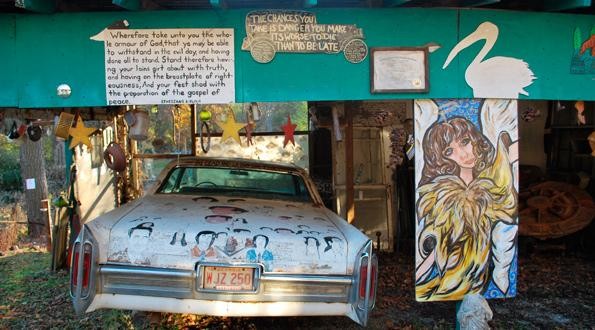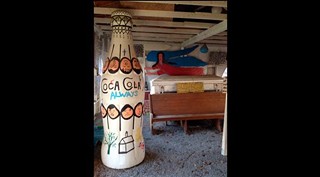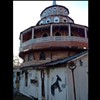There are plenty of things to give thanks for this week, whether they be family and health, work and play, good food and safe shelter, living in the U.S.A., or any combination thereof.
I have to say that the recent experience I'm most thankful for was the opportunity this past weekend to visit Howard Finster's Paradise Garden in Summerville, Ga. Frankly I've been so charged up about it since then that I simply had to share the experience with you.
As regular readers know, I author travel books in addition to my day gig at Connect. While researching the next book in the pipeline, a state guide to Georgia, at long last I was finally able to make the pilgrimage to the extreme northwest part of the state to visit the late Finster's deeply eccentric home/studio/workshop, named just this year to the National Register of Historic Places.
As a UGA grad from the heyday of R.E.M., I've always had an affinity for Finster's work, championed early on by the iconic Athens band. The recent Connect-sponsored Finster show at the Jepson Center over the summer was great, and I've also seen the standing Finster exhibit at the High Museum in Atlanta.
But folk art in a museum setting is like lipstick on a pig, or a tie football game: Unsatisfying.
When you drive through town on U.S. 27 and turn into the humble residential neighborhood where Paradise Garden lies -- double-wides and pickups, with a maximum security prison just down the way -- you viscerally sense the conflicted, paradoxical sources of Finster's outsider art.
Even that doesn't prepare you for the potentially life-changing (and certainly mind-blowing) experience of the Garden itself, filled to bursting with Finster's fertile, almost feverish visions of America, apocalypse, salvation, and the South.
And it's only then, seeing this place where the man lived and worked, that you get it. You get Howard Finster.
Like the world's weirdest theme park, Finster's drawing, painting, and craftwork cover just about every foot of available space on every structure on this swampy four-acre plot, from the front porch of the main house, to the "Meditation Room" and its pews and angel altar overseeing Finster's unoccupied "casket," to his bicycle repair shop, to the little handmade chapel in the west corner of the lot (spared by a recent tornado which hit just a few yards away), to the unwieldy multi-story "World's Folk Art Church" overlooking the whole neighborhood like a bizarre Himalayan temple, to the gospel-festooned old Cadillac "art car" that Finster used to drive through Summerville.
The almost impossibly prolific Finster is best known for his 2D paintings, but one of the things that strikes you about Paradise Garden is his clearly obsessive fascination with found art. A natural hoarder, Finster collected old stuff, large and small, of most any description, and was compelled to turn it into something, anything: Mosaics, sculpture, mobiles, you name it.
Here, you fully understand the provenance of the phrase, "one man's junk is another man's treasure."
And it's about here where my words just run out. It's the kind of thing you have to see and experience to really believe. If you ever make the pilgrimage to Summerville, make sure and save room for the fried catfish at Jim's Family Restaurant in town.































